January 2019
Contents
- General Announcements
- President’s Annual Report 2018
- Summary of the Seventh Meeting of the IAG EC 2015-2019
- 27th IUGG General Assembly, Montreal, Canada, July 8 – 18, 2019
- Meeting Announcements
- 5th IAG Symposium on Terrestrial Gravimetry: Static and Mobile Measurements
- Meetings Calendar
- IAG Sponsored Meetings
- 4th Joint International Symposium on Deformation Monitoring (JISDM)
- EUREF Symposium 2019
- 27th IUGG General Assembly
- 5th IAG Symposium on Terrestrial Gravimetry: Static and Mobile Measurements
- IAG Related Meetings
- Workshop on 'Global Navigation Satellite System (GNSS)'
- 3rd IVS Training School on VLBI for Geodesy and Astrometry
- 24th EVGA Working Meeting & 20th IVS Analysis Workshop
- Munich Satellite Navigation Summit 2019
- 2nd ISSI Workshop "Spacetime Metrology, Clocks and Relativistic Geodesy"
- EGU General Assembly 2019
- ION Pacific Positioning, Navigation and Timing (PNT) Conference
- IGS 2019 Analysis Workshop
- ESA Living Planet Symposium
- AOGS 16th Annual Meeting
- Earth & Geo Science-2019
- First International School on “Geoid Modelling, Gravity Inversion and its Applications”
- 4th Symposium of the Committee on Space Research (COSPAR)
- Book Review
- Willi Freeden, M. Zuhair Nashed (Editors): Handbook of Mathematical Geodesy. Functional Analytic and Potential Theoretic Methods
The IAG Newsletter is under the editorial responsibility of the Communication and Outreach Branch (COB) of the IAG.
It is an open forum and contributors are welcome to send material (preferably in electronic form) to the IAG COB (newsletter@iag-aig.org). These contributions should complement information sent by IAG officials or by IAG symposia organizers (reports and announcements). The IAG Newsletter is published monthly. It is available in different formats from the IAG new internet site: http://www.iag-aig.org
Each IAG Newsletter includes several of the following topics:
- news from the Bureau Members
- general information
- reports of IAG symposia
- reports by commissions, special commissions or study groups
- symposia announcements
- book reviews
- fast bibliography
General Announcements
President’s Annual Report 2018
2018 was another busy and successful year for IAG, and also my last full year of IAG presidency. My 2018 top highlights were
- the successful launch of the German-American satellite mission GRACE-FO (Gravity Recovery and Climate Experiment Follow-On) aboard a SpaceX Falcon 9 rocket from the Vandenberg Air Force Base (California) on May 22, 2018,
- the inauguration of the new twin VLBI telescopes at Ny-Ålesund, Svalbard, Norway, on June 6th, 2018,
- the 42th COSPAR Scientific Assembly taking place in Pasadena, USA, July 14-22, 2018,
- the conference week of UN-GGIM in New York, USA, during the first days of August, and
- two very efficient IAG Executive Committee meetings, the first one in Vienna, Austria, during the EGU General Assembly on April 13, 2018 and the second one in Washington D.C., USA, during the AGU Fall Meeting on December 10, 2018.
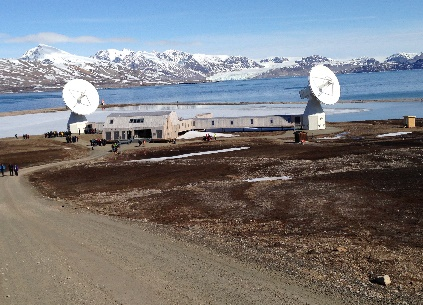
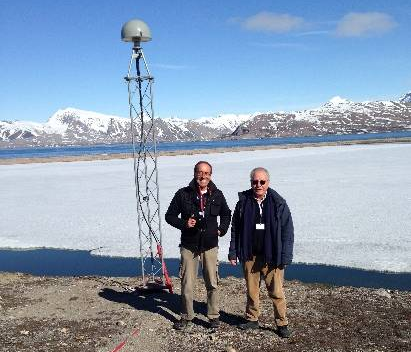
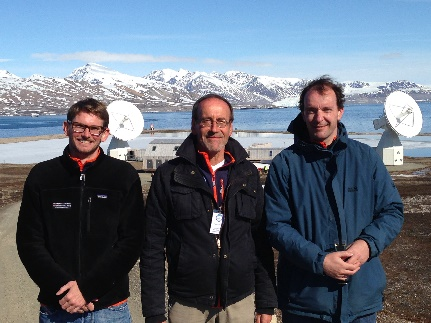
In the following, I would like to report briefly on some of my undertakings as IAG President in 2018.
10 days in July, I travelled through China and met a sizable number of Chinese colleagues at universities and research centers (e.g., at Hong Kong Polytechnic University, Shenzhen University, Hi-Target company in Guangzhou, Wuhan University, National Time Service Center of CAS, Xi’an). My talks on IAG and GGOS at Chang’an University in Xi’an and at the International Symposium on Geodesy and Geodynamics (ISGG2018) in Kunming were received with great interest. At ISGG 2018 I was also invited to give a welcome address on behalf of IAG.
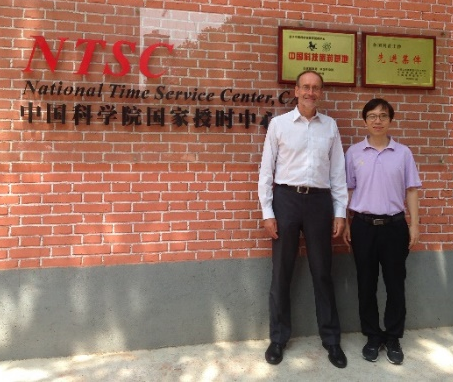
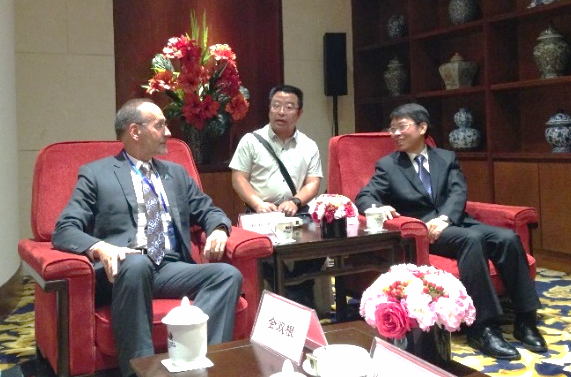
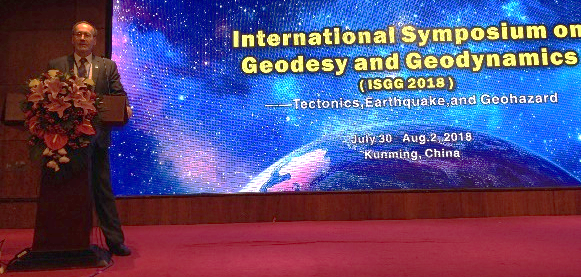
In the beginning of August, I participated in the UN-GGIM conference week with several splinter meetings about the GGRF (Global Geodetic Reference Frame) in New York, USA. On these events, please see my report in the IAG Newsletter of August 2018 at http://www.iag-aig.org/index.php?tpl=text&id_c=44&id_t=738#_Toc523478815.
Another personal highlight for me was the participation in the 9th International Workshop on TibXS (Multi-observations and Interpretations of Tibet, Xinjiang and Siberia), August 6-10, 2018, Zhangye, Gansu Province, in the Northwest of China, that was dealing with a lot of topics relevant to IAG.
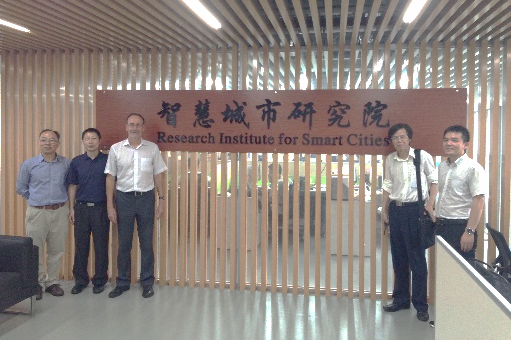
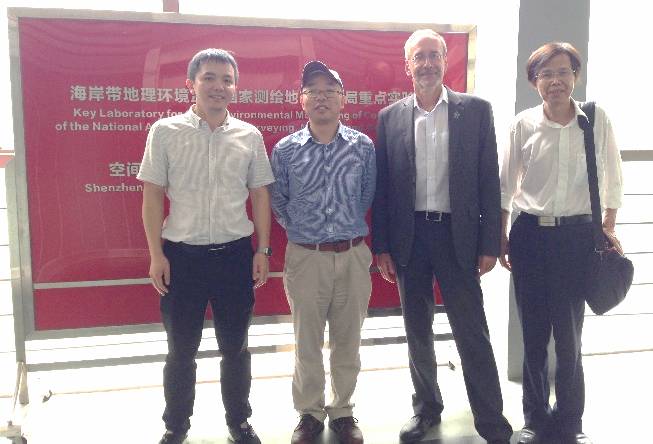
In the first week of October, I participated in the 2018 GGOS Days, hosted by the Geospatial Information Authority of Japan (GSI) at its headquarters in Tsukuba, Japan. Once again, the annual GGOS Days proved to be an essential meeting for further developing GGOS as a backbone entity of IAG.
In the last week of October, I travelled to Asia again: In Chingdao I visited Shandong University of Science and Technology, the University of Petroleum China (UPC), and the First Oceanic Institute. At the latter two institutions, I had the honour to deliver talks on IAG and its GGOS in our changing world. I travelled on to Wuhan, where I gave a talk on Developments in Geodesy from IAG Perspective at the International Top-Level Forum. In Wuhan, I also participated in the 2018 IGS Workshop hosted by Wuhan University. My welcome address on behalf of IAG received close attention. At the International Symposium on Geodesy & GNSS 2018 in Xuzhou, I gave again a welcome address on behalf of the IAG. My various travels to China in 2018 were aiming at acknowledging the growing activities and important role of Chinese geodesy. This fact was also demonstrated by the decision of the IAG Council to hold the IAG Scientific Assembly 2021 in Beijing, China.
In November, I travelled a last time that year to Asia and participated in the annual International Symposium on GNSS, the open forum for international researchers and practitioners especially in the Asia Pacific region, that took place in Bali, Indonesia, from 21 to 23 November, 2018. At this symposium, GNSS experts from several Asian countries met with international partners. Studies and new findings about recent natural hazards in the Indonesian archipelago were of highest interest.
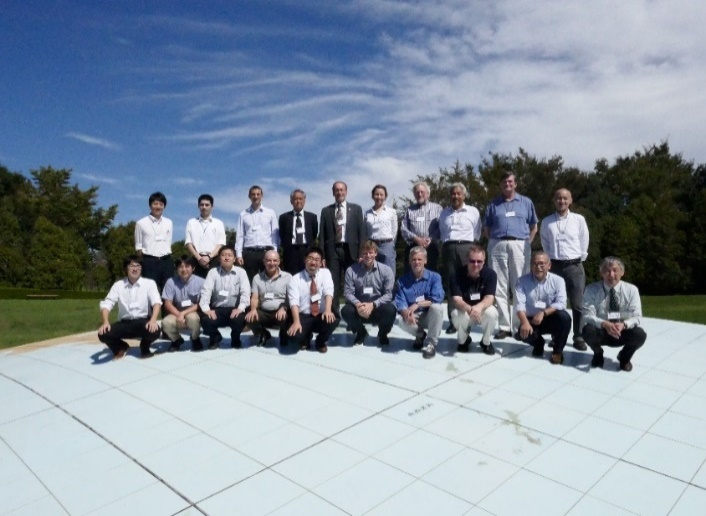
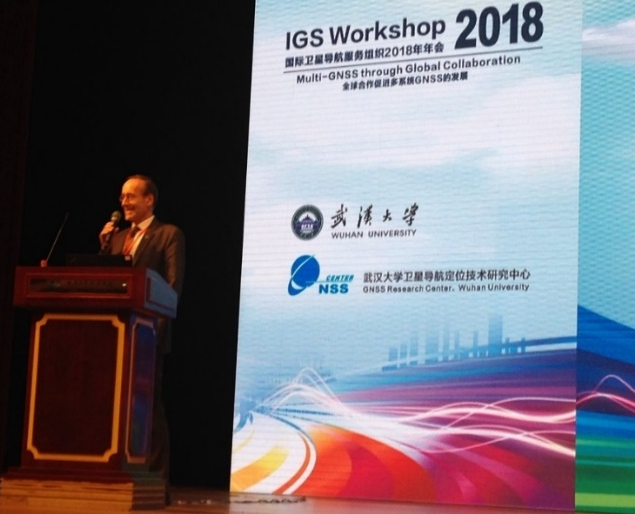
Concerning the IAG strategic planning process, we had another round of discussion at the two EC meetings in 2018 and finalized the IAG Strategy Document to be approved by the IAG Council at the IUGG General Assembly in Montreal in July 2019. Several of the recommendations and action items postulated in the Strategy Document have already been realized in the course of the last two years. I am particularly glad to report here that the EC decided to establish new bodies within the IAG and also as inter-association entities. These are:
- A Planning Group on “Marine Geodesy” to establish an Inter-commission committee at IUGG2019 in Montreal (Chair: Yuanxi Yang),
- A Planning Group on “Geodesy for Climate Research” to establish an Inter-commission committee at IUGG2019 in Montreal (Chairs: Roland Pail and Annette Eicker),
- A Planning Group on “Seismo-Geodesy” to establish an Inter-commission project at IUGG2019 in Montreal (Chair: tbd),
- A Planning Group on “Novel Geodetic Sensors and Technologies” to establish an IAG project at IUGG2019 in Montreal (Chair: Jürgen Müller).
Everybody interested to participate in one of these Planning Groups should contact its Chair or the IAG Secretary General Hermann Drewes.
In closing, I would like to thank all colleagues in the Bureau and Executive Committee of IAG for their support and collaboration in 2018, and Hermann Drewes and his Assistant Franz Kuglitsch for their unwavering commitment to the Association.
And one more final remark: I am looking forward to meet many IAG colleagues during the 27th IUGG General Assembly in Montréal, Canada, in July and I admit that I am absolutely delighted of the impressive program set up. Apart from most interesting Union lectures and a cutting-edge IAG symposia program, there is – as intended by IUGG and its components – a totally novel variety of inter-Association symposia. In Montréal, we will have an interdisciplinary approach indeed!
HARALD SCHUH
IAG President
Summary of the Seventh Meeting of the IAG EC 2015-2019
Place: Marriott at Metro Center, Penn Quarter Room, 12th Street NW, Washington DC, USA
Time: Monday, 10 December 2018, 09:00 – 18:00
Attendees (voting): H. Schuh (IAG President), Z. Altamimi (IAG Vice President), H. Drewes (IAG Secretary General), G. Blewitt (President of Commission 1), R. Pail (President of Commission 2), M. Santos (President of Commission 4), P. Novák (President of ICC on Theory), R. Gross (Chair of GGOS), A. Nothnagel (Representative of the Services), Y. Dang (Member-at-Large), S. Rozsa (substitute of President of the COB), C. Rizos (Immediate Past President (via telecom during agenda items 13 and 14)
Attendees (non-voting): F. Kuglitsch (IAG Assistant Secretary General, minute taker), M. Sideris (IAG Past President)
Guests: J. Kusche (Editor in Chief, Journal of Geodesy), J. Freymueller (Editor in Chief, IAG Symposia Series, during agenda item 11), G. Johnston (Chair of the IGS Governing Board, during agenda item 7)
Regrets: M. Hashimoto (President of Commission 3), J. Adám (President of the COB), R. Barzaghi, R. Neilan (Representatives of the Services), C. Pacino (Member-at-Large)
Summary of Agenda Items:
1. Welcome and adoption of agenda
The 7th IAG EC Meeting in the term 2015-2019 took place on 10 December 2018 on the occasion of the AGU Fall Meeting 2018 at Marriott at Metro Center, Penn Quarter Room, 775 12th Street NW in Washington DC, USA. The agenda was distributed previously by e-mail and was unanimously adopted. H. Schuh, the President of the IAG, welcomed the members of the IAG Executive Committee (11 out of 16 voting members, 2 non-voting members and 3 guests). The EC Members approved the minutes of the 6th IAG EC Meeting in the term 2015-2019, which took place on 13 April 2018 in Vienna, Austria.
2. Reports of the Commissions
G. Blewitt gave the presentation about Commission 1 (Reference Frames). He reported about the work of the four Sub-commissions and the Joint Working Group 2.1 (Relativistic Geodesy). He further reported about the meeting on Reference Frames for Applications in Geosciences (REFAG), which was organized during the COSPAR Assembly in July 2018, in Pasadena, CA, USA and summarized the preparations of Commission 1 for the IUGG General Assembly 2019.
R. Pail gave the presentation about Commission 2 (Gravity Field). He reported about the International Symposium on Gravity, Geoid and Height Systems 2 (GGHS), which was organized in September 2018, in Copenhagen, Denmark, the preparations for the IUGG General Assembly 2019 and other meetings. He presented a proposal for a new Joint Working Group (JWG 2.1.2; Unified file formats and processing software for high-precision gravimetry) and for a new subcomponent dealing with Geodesy for Climate Research. The EC Members agreed on establishing a Joint Working Group on “Unified file formats and processing software for high-precision gravimetry”
On behalf of M. Hashimoto, R. Gross gave the presentation about Commission 3 (Earth Rotation and Geodynamics). He reported about the work of the five Sub-commissions. He further reported about the 19th WEGENER General Assembly, which was organized in September 2018 in Grenoble, France, the work of the Joint Working Group 3.1 (Theory of Earth Rotation and Validation), the Joint Working Group 3.2 (Constraining vertical land motion of tide gauges), and joint inter-association activities with IASPEI and IAVCEI. He summarized recent developments on establishing an IAG subcomponent “Marine Geodesy”. H. Drewes suggested writing ToR including the structure for the new Sub-commission 3.2 (Volcano Geodesy), and to think about possible Study and Working Groups and members.
M. Santos gave the presentation about Commission 4 (Positioning and Applications). He reported about the work of the four Sub-commissions. He further noted that Sub-commission 4.2 (Geo-spatial Mapping and Geodetic Engineering) has not submitted a report, however, he confirmed that Sub-commission 4.2 is active.
3. Report of the Inter-Commission Committee on Theory
P. Novák gave a presentation about ICCT. He reported about the 9th Hotine-Marussi Symposium on Mathematical Geodesy, which was organized by ICCT in June 2018, in Rome, Italy.
4. Report of the Communication and Outreach Branch
S. Rozsa reported about current COB activities. He highlighted the IAG website, the IAG newsletter, GIM International, Social Media, and the UN GGIM WG (focus group on Outreach and Communication). He underlined the need to get regularly news/input for the IAG website, newsletter and social media. In addition, he noted that IAG should implement a Privacy Policy following the EU General Data Protection Regulation (GDPR). F. Kuglitsch offered sending the IUGG Privacy Policy to S. Rozsa.
5. Establishment of (if necessary Planning Groups for) IAG Projects or Inter-commission Committees: “Marine Geodesy”, “Novel Technologies and Sensors”, “Geodesy for Climate Research”
H. Schuh summarized the proposal on establishing a subcomponent on “Marine Geodesy”. The EC Members agreed on establishing a Planning Group on “Marine Geodesy” with the aim to establish an Inter-commission Committee at IUGG2019 in Montreal. Possible committee members should be identified. H. Schuh noted that Heidrun Kopp is a Professor for Marine Geodesy in Kiel, Germany, who could act as a possible member of the Planning Group. Y. Dang suggested asking Prof. Y. Yang from Shanghai, China, to act as a possible Planning Group Chair. If he agrees, ToR for this Committee should be developed until IUGG2019 and possible project members should be identified.
R. Pail summarized the proposal on establishing a subcomponent on “Geodesy for Climate Research”. The EC Members approved the proposal on “Geodesy for Climate Research” as a Planning Group with the aim to establish an Inter-commission committee at IUGG2019 in Montreal. R. Pail agreed on setting up an appropriate structure together with A. Eicker (as Planning Group Chair) and invited the EC Members to provide ideas for the structure and names for possible members.
H. Schuh summarized the proposal on establishing a Planning Group on “Novel Geodetic Sensors and Technologies”. He clarified that this Planning Group should now start to consolidate with the aim to establish an IAG project at IUGG2019 in Montreal. J. Müller already agreed on taking the lead (as Planning Chair) on this project.
The EC Members discussed the importance of strengthening Seismo-Geodesy within IAG and concluded that Sub-commission 3.5 (and IASPEI) should do more work in this field. The EC Members agreed on establishing a Planning Group on “Seismo-Geodesy” with the aim to establish an Inter-commission project on Seismo-Geodesy at IUGG2019 in Montreal. Possible committee members should be identified. H. Drewes noted that the project should consist of a Chair, Vice-Chair and Steering Committee (including members from all Commissions) to be appointed by the EC Members. In addition, the project should consist of Working Groups with a Chair, Vice-Chair and members. The project Chair should follow IAG By-Law 16.
6. Report of the Global Geodetic Observing System, GGOS
R. Gross gave a presentation about the current activities of Global Geodetic Observing System (GGOS). He reported about the GGOS Structure, the GGOS Coordinating Office, the GGOS Focus Areas, GGOS Affiliates, the GGOS Bureau of Products & Standards, DOIs for Geodetic Data, the GGOS 2018 Days in Tsukuba, Japan, other past and future meetings, and the revised ToR. The EC Members approved the revised GGOS.
7. Reports of the Services’ representatives
G. Johnston gave the first presentation about the current activities of IGS. He reported about the 2018 IGS Workshop, which was organized in Wuhan, China, the IGS Multi-GNSS Working Group, the new IGS Working Group on PPP Ambiguity Resolution, the IGS recommendations to International Laser Ranging Service (ILRS), the Real Time GNSS Service (RTS), new standards, project preparations and upcoming events.
On behalf R. Barzaghi, R. Pail gave the second presentation about the Services. He reported about recent activities of the following Gravity Field Services:
- International Gravity Field Service (IGFS),
- International Gravimetric Bureau (BGI),
- International Service for the Geoid (ISG),
- International Geodynamics and Earth Tide Service (IGETS),
- International Center for Global Earth Models (ICGEM),
- International DEM Service (IDEMS), and
- International Combination Service for Time-variable Gravity Field Solutions (COST-G).
A. Nothnagel gave the third presentation about the Services. He reported about recent activities of the following Services:
- International Earth Rotation and Reference Systems Service (IERS),
- International DORIS Service (IDS),
- International Laser Ranging Service (ILRS),
- International VLBI Service for Geodesy and Astrometry (IVS), and
- Permanent Service for Mean Sea Level (PSMSL).
There was no report available from the Bureau International des Poids et Mesures (BIPM). H. Drewes noted that IAG has good contact with BIPM. The new head of the time department is P. Tavella.
No report was available from R. Neilan.
8. International Altimetry Service (IAS): Draft Terms of Reference & Call for Proposals
H. Schuh mentioned that IAS has been inactive since 2015. R. Pail suggested structuring IAS rather as a Product Center than a Service (comparison with COST-G). H. Drewes noted that IAS should offer a product if it is re-established as a Service. R. Gross offered including IAS a Focus Area in GGOS. H. Schuh suggested asking C.K. Shum and his group to plan the next steps (e.g., to set up a Planning Group; to set up a call for participation; to include IAS as a Focus Area in GGOS). H. Drewes agreed on asking C.K. Shum to take the lead on that and to interact with Sub-commission 2.5.
9. Report of the Members-at-Large
Y. Dang gave a presentation about recent geodetic activities in Asia Surrounding Regions, and the organization plan for the IAG Scientific Assembly 2021 to be held in Beijing, China. H. Schuh suggested holding the IAG Scientific Assembly 2021 rather from Monday to Friday than over a weekend (as proposed by Y. Dang).
There was no report available from M. C. Pacino.
10. Report on the Journal of Geodesy
J. Kusche gave the presentation about the Journal of Geodesy. He reported about changes in the Editorial Board, major numbers and statistics of the Journal of Geodesy, Special Issues, editorial practices and new policies including the author contribution statement and data availability statement. The EC Members discussed the possibilities of digitizing Manuscripta Geodaetica. H. Schuh invited the EC Members to search for possibilities to digitize Manuscripta Geodaetica at their institutes.
11. Status of the IAG Symposia Series
J. Freymueller gave the presentation about the IAG Symposia Series. He reported about the status of recent and active volumes including GGHS 2016, IAG-IASPEI Joint Scientific Assembly 2017, and the Hotine-Marussi Symposium 2018, recurring problems and recommendations. H. Schuh clarified that already at the 6th EC Meeting in Vienna, it was decided that the IAG Symposia Series should become open access. H. Drewes mentioned that he was in contact with Springer and noted that open access for a series of up to 200 pages would costs EUR 6,000. Open access for a series of 201-500 pages would cost EUR 14,250. Open access for a series of 501-1,000 pages would costs EUR 21,600. H. Drewes mentioned that IAG could cover the costs for open access of the IUGG General Assembly and IAG Scientific Assembly Series. Z. Altamimi and J. Freymueller suggested increasing the registration fee for the other symposia to cover the costs for publishing open access. Participants of the symposia should be informed about the open access publishing well in advance. The EC Members agreed on making the future IAG Symposia Series open access starting at IUGG2019 in Montreal. The head fee should be USD 50. H. Drewes agreed on informing Springer accordingly.
12. Status of the IUGG General Assembly, Montreal, Canada, 8-18 July 2019
H. Drewes mentioned that the scientific program for IUGG 2019 is now complete (see http://iugg2019montreal.com/. He mentioned that the abstract deadline is on 18 February 2019. H. Schuh encouraged the EC Members to advertise IUGG2019 whenever possible.
13. Revision of the IAG Statutes and Bylaws
C. Rizos presented the report of the Cassinis Committee and the revised IAG Statutes and Bylaws via telecon. H. Drewes invited the EC Members to read the revised IAG Statutes and Bylaws and to give further comments. C. Rizos agreed on implementing final changes to the revised IAG Statutes and Bylaws by the end of January 2019 and circulating this version among the EC Members. In the middle of February 2019, the IAG Council Members should be asked to give further comments on the revised IAG Statutes and Bylaws.
14. Nomination procedure for IAG officers 2019-2023
C. Rizos presented the report of the Nominating Committee. He confirmed that he has received at least two nominations for each position. H. Drewes clarified that the EC Members are not directly involved in the nominating process, which is a task of the Council. H. Schuh suggested C. Rizos to ask the nominated people whether they have enough travel support from their institutions when they accept their nomination.
15. Interview with candidates for IAG Secretary General 2019-2023
H. Schuh welcomed the two candidates for the IAG Secretary General 2019-2023 and clarified that the Council will make the final decision about the future IAG Secretary General at IUGG2019. The EC Members will give a recommendation to the Council based on the interviews today. H. Schuh summarized the role and tasks of the IAG Secretary General (as defined by the IAG Bylaws). H. Drewes noted that the workload of the IAG Secretary General is typically around 2.5 days per week on average. After interviewing the candidates, the EC Members agreed that the candidates are well qualified for the position of the IAG Secretary General.
IAG strategy discussion
H. Schuh summarized the IAG Strategy document and noted that final updates need to be done. He invited the EC Members to add further suggestions for revision until 7 January 2019. H. Drewes agreed on finalizing the document. The EC Members agreed that once the Strategy document is finalized it should be distributed together with the Guiding document among the Council Members for information.
16. Report from IUGG and ICSU
F. Kuglitsch reported about the status of the IUGG Member Countries, proposed candidates for the IUGG Bureau and Finance Committee 2019-2023, IUGG Awards, preparations and deadlines related to the IUGG General Assembly 2019 and the Centennial celebrations, and news from the International Science Council (ISC). H. Schuh invited the EC Members to suggest more candidates for IUGG Awards in future.
17. Liaisons with international scientific and professional bodies
H. Drewes discussed the list of IAG Representatives to Scientific Bodies, which is published at https://iag.dgfi.tum.de/fileadmin/IAG-docs/IAG_Representatives_2018.pdf. R. Gross noted that he is still trying to find a new IAG Representative to UNOOSA (United Nations Office for Outer Space Affairs) and confirmed that C. Rizos became the IAG Representative to ICG.
18. IAG sponsored meetings
H. Drewes discussed the list of IAG sponsored meetings (https://iag.dgfi.tum.de/en/meetings-calendar/).
19. Any other business
F. Kuglitsch noted that IAG has around 220-240 individual members. Around 170 people are paying members; around 50 people are either student or lifetime member who do not pay membership fees. He mentioned that the fee for an IAG individual membership is USD 50 for 1 year or USD 150 for 4 years. H. Drewes urged the EC Members to advertise the IAG student membership, which is free of charge. H. Schuh and M. Sideris highlighted the importance of encouraging more young people getting involved in IAG activities (e.g., Working Groups).
The EC Members confirmed to organize the next IAG EC Meetings on occasion of the IUGG General Assembly 2019 in Montreal, Canada, on Monday, 8 July 2019 from 09:00-13:00, and possibly on 15 or 16 July and on 18 July 2019 from 16:00-19:00.
H. Schuh announced a new table of IAG Service Contributions by Organizational Categories (https://iag.dgfi.tum.de/fileadmin/IAG-docs/IAG_Service_Contributions_20181210.pdf). The GGOS Bureau of Networks and Observations collected the information.
20. Adjournment
H. Schuh thanked the participants for their contributions and closed the session at 18:20.
Respectfully submitted
F. Kuglitsch, Assistant Secretary General
H. Drewes, Secretary General
27th IUGG General Assembly, Montreal, Canada, July 8 – 18, 2019

The International Union of Geodesy and Geophysics (IUGG) holds its 27th General Assembly from July 8 to 18, 2019 in Montreal, Canada. The general assembly theme is the celebration of the centennial of the IUGG establishment in Brussels, Belgium, in 1919.
IUGG holds its General Assemblies every four years. Traditionally, the eight constituent associations of IUGG (Cryospheric Sciences, IACS; Geodesy, IAG; Geomagnetism and Aeronomy, IAGA;
Hydrological Sciences, IAHS; Meteorology and Atmospheric Sciences, IAMAS; Physical Sciences of the Ocean, IAPSO; Seismology and Physics of the Earth's Interior, IASPEI; and Volcanology and Chemistry of the Earth's Interior, IAVCEI) arrange their General Assemblies in parallel with the IUGG. This enables to hold joint inter-association symposia besides the specific association symposia and a greater involvement in the IUGG symposia.
There will be nine Union Symposia organized by IUGG and each of the associations in cooperation with the IUGG Commissions (Climatic and Environmental Changes, CCEC; Mathematical Geophysics, CMG; Geophysical Risk and Sustainability, GRC; Study of the Earth's Deep Interior, SEDI; Data and Information, UCDI; Planetary Sciences, UCPS), the IUGG Working Group on History (WGH), and the Global Geodetic Observing System (GGOS).
- U1 - Achieving Sustainable Development: The Role for Earth Sciences (IACS, CCEC),
- U2 - Georisk Reduction: Science, Resources, and Governmental Action (IAVCEI, GRC),
- U3 - Mathematics of Planet Earth: The Science of Data (IASPEI, CMG),
- U4 - Data-driven Science for Earth and Space Exploration (IAPSO, UCDI),
- U5 - New Discoveries in Earth Deep Interior (IAGA, SEDI),
- U6 - Recent Advances and Discoveries in Planetary Science and Comparative Planetology (IAMAS, UCPS),
- U7 - Centennial of the International Cooperation in Earth Sciences (IAHS, WGH),
- U8 - Earth and Space Observations (IAG, GGOS),
- U9 - Celebrating Early Career Scientists (IUGG).
- David Grimes (IUGG): Earth Sciences as the Underlying Pillars to Meet Societal Challenges in the next Century;
- Waleed Abdalati (IACS): Exploring and Understanding Earth from Space: The Power of Perspective;
- Kosuke Heki (IAG): No geodesy, no geophysics;
- Lisa Tauxe (IAGA): Hunting the magnetic field;
- Veena Srinivasan (IAHS): Understanding and transforming water conflicts in the Anthropocene;
- Ed Hawkins (IAMAS): The value of rescuing millions of lost historical weather observations using volunteer citizen scientists;
- Karen Kohfeld (IAPSO): The Ocean’s Role in Atmospheric Carbon Dioxide Changes During Ice Age Cycles;
- Vera Schlindwein (IASPEI): Singing seismograms – harmonic tremor signals in seismological records;
- Paolo Papele (IAVCEI): Volcanic giants - what we know, what we think we know, what we can’t know about cataclysmic super-eruptions.
The joint symposia are always led by an association with co-conveners from other associations. IAG has the lead of the following Inter-Association Symposia:
- JG01 - Interactions of Solid Earth, Ice Sheets and Oceans;
- JG02 - Theory and Methods of Potential Fields;
- JG03 - Near-Real Time Monitoring of Regional to Global Scale Water Mass Changes;
- JG04 - Geodesy for Atmospheric and Hydrospheric Climate Research;
- JG05 - Remote Sensing and Modelling of the Atmosphere;JG06 - Monitoring Sea Level Changes by Satellite and In-Situ Measurements;
- JG07 - Monitoring, Imaging and Mapping of Volcanic Belts;
- JG08 - Earth Systems Literacy: Geophysics in K-16 Class Rooms, Outreach Projects, and Citizen Science Research Projects;
and IAG is sponsoring (with IAG co-conveners) the following Inter-Association Symposia led by other associations:
- JA01 - Geophysical Constraints on the Earth's Core and Its Relation to the Mantle;
- JA02 - Geophysical Data Assimilation;
- JA03 - Geophysical Records of Tectonic and Geodynamic Processes;JA06 - Space Weather Throughout the Solar System: Bringing Data and Models Together;
- JA07 - Geoscience Data Licensing, Production, Publication, and Citation (IAGA);
- JA08 - Probing the Earth’s Lithosphere and Its Dynamics Using Geophysical Modeling;
- JH02 - Climate and Hydrological Services: Bridging from Science to Practice and Adaptation;
- JP01 - Tides of the Oceans, Atmosphere, Solid Earth, Lakes and Planets;
- JS01 – Cryoseismology;
- JS02 - Early Warning Systems for Geohazards;
- JS03 - Subduction Zone Deformation and Structure: Tracking the Sea Floor in Motion;
- JS04 - Seismo – Geodesy;
- JS05 - Probabilistic & Statistical Approaches in Geosciences;
- JS06 - Old Data for New Knowledge: Preservation and Utilization of Historical Data in the Geosciences;
- JS07 - Integrated Geophysical Programs for Earth Systems Monitoring;
- JV03 - Strain Localisation and Seismic Hazards.
The IAG specific symposia are the main issue of the IAG General Assembly:
- G01 - Reference Systems and Frames;
- G02 - Static Gravity Field and Height Systems;
- G03 - Time-variable Gravity Field;
- G04 - Earth Rotation and Geodynamics;
- G05 - Multi-signal Positioning, Remote Sensing and Applications;
- G06 - Monitoring and Understanding the Dynamic Earth with Geodetic Observations.
For all details of the symposia descriptions and the program, please visit the IUGG2019 Homepage (http://iugg2019montreal.com/). The most important deadlines are:
- February 18, 2019: Closing of abstract submission;
- February 18, 2019: Closing of Grant application submission;
- March 30, 2019: Abstract acceptance sent to participants;
- April 5, 2019: Early-bird registration closes.
IAG invites all geodesists to participate in the General Assembly 2019 and to present their work in one of the symposia. We look forward to seeing you in Montreal!
HERMANN DREWES
IAG Secretary General
Meeting Announcements
5th IAG Symposium on Terrestrial Gravimetry: Static and Mobile Measurements
5th INTERNATIONAL ASSOCIATION OF GEODESY (IAG)
SYMPOSIUM ON TERRESTRIAL GRAVIMETRY:
STATIC AND MOBILE MEASUREMENTS
1-4 October 2019
Saint Petersburg, Russia
The 5th International Association of Geodesy (IAG) Symposium on Terrestrial Gravimetry: Static and Mobile Measurements will be held by the State Research Center of the Russian Federation - Concern Central Scientific and Research Institute Elektropribor, JSC, on 1-4 October 2019.
Organizers:
- International Association of Geodesy (IAG);
- State Research Center of the Russian Federation - Concern Central Scientific and Research Institute Elektropribor, JSC.
With the support of:
- International Public Association – Academy of Navigation and Motion Control (ANMC);
- D.I.Mendeleyev Institute for Metrology (VNIIM);
- Journal Gyroscopy and Navigation.
The symposium topics include instrumentation and methods for absolute and relative static and mobile measurement of gravity field at all kind of mobile platforms – shipborne, airborne (airplanes, helicopters, airships), satellites:
- absolute ballistic gravimeters (including that based on the use of cold atoms), relative gravimeters of all types including superconducting gravimeters;
- nstrumentation for terrestrial and satellite measurement of second derivatives of gravity field potential as
- satellite accelerometers
- satellite gravity gradiometers like for GOCE
- K-Band measurement systems as for GRACE and GRACE-FO
- spaceborne laser interferometers as for GRACE-FO
- new technologies, equipment and materials for development of all types of gravity measurement instrumentation new methods and results in the gravity data processing including data combinations from various gravity measuring systems, unification of the file format for absolute gravity measurement;
- new results of shipborne, airborne gravity survey coverage, unified reference frame for shipborne, airborne gravity surveys
- new results of measurement of gravity networks and the coverage of new regions;
- metrology issues in the measurement of free fall acceleration and of the second derivatives of gravity potential, application of gravity measurement in metrology, gravitational comparisons of absolute gravimeters;
- standardization and databases of absolute measurements of the gravity field;
- gravitational experiments including the measurement of gravitational constant.
The following topics are especially welcome for presentation at the Symposium:
- new technologies and applications of gravity measurements as planetary absolute and relative gravimetry;
- links between satellite and terrestrial or planetary gravity field measurements;
- applications of terrestrial gravimetry in combination with GNSS/InSAR techniques;
- gravimetry application in navigation.
INTERNATIONAL SCIENTIFIC COMMITTEE
Chairman: Academician of the Russian Academy of Sciences,
Prof. Vladimir Peshekhonov – Russia
Vice-chairman: Dr. Hartmut Wziontek – Germany
LOCAL ORGANIZING COMMITTEE (Russia)
Chairman: PhD. Alexander Sokolov
Vice-chairs: Dr. Leonid Vitushkin
Mrs. Margarita Grishina
All presentations at the Conference will be held in English or Russian and will be simultaneously interpreted.
CONTACT INFORMATION
State Research Center of the RF
Concern CSRI Elektropribor, JSC
30, Malaya Posadskaya Ul., St. Petersburg,
197046, Russia
Tel: +7(812) 499 81 18, +7(812) 499 81 57
Fax: +7(812) 232 33 76
e-mail: tgsmm@eprib.ru
Web-site - http://www.elektropribor.spb.ru/tgsmm2019/eindex
ROLAND PAIL
Meetings Calendar
IAG Sponsored Meetings
4th Joint International Symposium on Deformation Monitoring (JISDM)
May 15 – 17, 2019, Athens, Greece
URL: http://jisdm2019.survey.ntua.gr/
EUREF Symposium 2019
May 22 – 24, 2019, Tallinn, Estonia
URL: http://www.maaamet.ee/euref2019
27th IUGG General Assembly
July 8 – 17, 2019, Montreal, Canada
URL: http://www.iugg.org/assemblies/
5th IAG Symposium on Terrestrial Gravimetry: Static and Mobile Measurements
October 1 – 4, 2019, Saint Petersburg, Russia
URL: http://www.elektropribor.spb.ru/tgsmm2019/eindex
IAG Related Meetings
Workshop on 'Global Navigation Satellite System (GNSS)'
March 9, 2019, Delhi, India
URL: http://aprasc2019.com/global-navigation-satellite-system-gnss/
3rd IVS Training School on VLBI for Geodesy and Astrometry
March 14-16, 2019, Las Palmas de Gran Canaria, Spain
URL: http://wp.portal.chalmers.se/evga/vlbi-school-2019/
24th EVGA Working Meeting & 20th IVS Analysis Workshop
March 17-19, 2019, Las Palmas de Gran Canaria, Spain
URL: http://www.oan.es/evga2019/index.shtml
Munich Satellite Navigation Summit 2019
March 25-27, 2019, Munich, Germany
URL: https://www.munich-satellite-navigation-summit.org/
2nd ISSI Workshop "Spacetime Metrology, Clocks and Relativistic Geodesy"
March 25-29, 2019, Bern, Switzerland
URL: http://www.issibern.ch/teams/spacetimemetrology/index.php/schedule-meetings/
EGU General Assembly 2019
April 7-12 , 2019, Vienna, Austria
URL: http://www.egu2019.eu/
ION Pacific Positioning, Navigation and Timing (PNT) Conference
April 8-11 , 2019, Honolulu, Hawaii, USA
URL: https://www.ion.org/pnt/
IGS 2019 Analysis Workshop
April 15-17, 2019, Potsdam, Germany
URL: https://www.iers.org/IERS/EN/NewsMeetings/ForthcomingMeetings/forthcoming.html
ESA Living Planet Symposium
May 13-17 , 2019, Milan, Italy
URL: https://lps19.esa.int
AOGS 16th Annual Meeting
July 28 – August 2, 2019, Singapore, Singapore
URL: http://www.asiaoceania.org/society/public.asp?view=up_coming
Earth & Geo Science-2019
August 12-13, 2019, Prague, Czech Republic
URL: https://scientificfederation.com/earth-science-2019/
First International School on “Geoid Modelling, Gravity Inversion and its Applications”
September 9-13, 2019, Gävle, Sweden
URL: https://www.hig.se/4.6c77c68166435adf0b3d060.html
4th Symposium of the Committee on Space Research (COSPAR)
November 4-8, 2019, Herzliya, Israel
URL: http://www.cospar2019.org/
Book Review
Willi Freeden, M. Zuhair Nashed (Editors): Handbook of Mathematical Geodesy. Functional Analytic and Potential Theoretic Methods
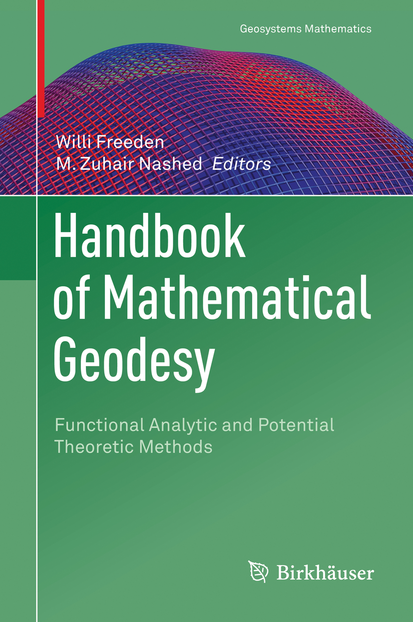
Title: Handbook of Mathematical Geodesy. Functional Analytic and Potential Theoretic Methods
Author: Willi Freeden, M. Zuhair Nashed (Editors)
Publisher: Birkhäuser
ISBN: 978-3-319-57181-2
Year: 2018
Price: € 139.99 (Hardcover), € 118.99 (eBook)
Details: 1st edition, XIV, 932 pages 155 illustrations, 76 illustrations in color.
The Handbook of Mathematical Geodesy belongs to the Series ’Geosystems Mathematics’ with the Series editors W. Freeden and M. Z. Nashed. It deals with understanding the system Earth and is driven by the public concern about the future of our planet, its climate and its environment. ’Geosystems Mathematics’ tries to advance the cooperation between mathematics and geodisciplines.
The Handbook of Mathematical Geodesy starts with an Introduction by W. Freeden and then presents fifteen different contributions, which will be put forward in the following.
W. Freeden begins his introduction with F. R. Helmerts famous definition that geodesy is the science that deals with the measurement and the modeling of the Earth, including its gravity field. W. Freeden states that the goal of the Handbook of Mathematical Geodesy is twofold: to make the mathematicians aware of the tools, which geodesists are using for analyzing their measurements at the surface of the Earth or in space, and make the geodesists conscious of the abstract methods the mathematicians apply for handling measurements.
The first contribution ’Gauss as Scientific Mediator Between Mathematics and Geodesy from the Past to the Present’ with 163 pages was written by Willi Freeden, Thomas Sonar, and Bertold Witte. The authors begin with taking a look at his life in the introduction, and it is amazingly what Gauss has accomplished. Then, they go from the Gaussian circle problem to geosampling, from Gaussian integration to geocubature, from the Gaussian theorem to geoidal determination. Stokes determined the geoid, and Molodensky introduced the height anomaly leading to the telluroid. Gaussian least squares adjustment and the inverse multi-scale regularization follow with the graphical illustration of the shape of the Earth, and finally Gaussian geometry and geodetic surveying.
The second contribution to the Handbook of Mathematical Geodesy ’An Overview on Tools from Functional Analysis’ with 35 pages was written by Matthias Agustin, Sarah Eberle, and Martin Grothaus. The authors start with the basic concepts, which are metric spaces, formed spaces, Banach spaces, and linear operators. They move on to the function spaces with properties of convolutions, Hausdorff Measure, and Fourier Transformation. Finally, differential equations, and reproducing kernel functions are presented.
The third contribution ’Ill-Posed Problems: Operator Methodologies of Resolution and Regularization,’ with 114 pages was written by Will Freedmen and M. Zuhair Nashed. This is a classical topic in the research of mathematical geodesy. The editors and publishers therefore decided to include this contribution although its content has been extracted from W. Freeden, M. Z. Nashed, Operator Theory and Regularization Approaches to Ill-Posed Problem, GEM Int. J. Geomath., Springer, 2017. The authors present first the solvability of ill-posed operator equations with the pseudoinverse, Tikhonov regularization, least squares problems and generalized inverses, then operator methodologies of resolution, and reconstruction methods and regularizing filters.
The fourth contribution ’Geodetic Observable and Their Mathematical Treatment in Multiscale Framework’ with 144 pages was written by Will Freeden and Helga Nutz. The current state of gravity field determination by gravity measurements, vertical deflections, satellite-to-satellite tracking, and satellite gravity gradiometry is reviewed first. The geodetically relevant Sobolev spaces, the pseudodifferential operators and geodetic nomenclature, the reproducing kernel structures and observational functionals, the ill-posedness of satellite problems, the geodetically oriented wavelet approximation, the bandlimited Runge-Walsh multiscale approximation, Meissl schemata are then introduced together with several illustrations. The Appendix defines geodetic notions and explains, how they are observed.
The fifth contribution ’The Analysis of the Geodetic Boundary Value Problem: State and Perspectives’ with 31 pages was written by Fernando Sansò. The author explains in the first three lines of the introduction that the Geodetic Boundary Value Problem (GBVP) determines the figure of the Earth from as many as possible measurements on the gravity field and the least possible knowledge of the geometry. This was acceptable before the space era but is not realistic anymore, as the Global Positioning System (GPS) or the Global Navigation Satellite System (GNSS) determines in any point its coordinates. The geometry could be assumed as known already in 1992, when Koch and Pope proved the uniqueness and existence of the GBVP using the known surface of the Earth. F. Sansò continues by moving from the vector to the scalar GBVP, then to linearizing the scalar GBVP in geometry space, to the analysis of the simple Molodensky problem, and to the analysis of the linearized scalar GBVP. In the conclusions he admits that the theory of the fixed GBVP requires much weaker conditions to obtain a theorem of existence uniqueness.
The sixth contribution ’Oblique Stochastic Boundary Value Problem’ with 26 pages was written by Martin Grothaus and Thomas Raskop. The aim of the contribution is finding weak solutions to oblique boundary value problems. After citing results for the existence of the deterministic problem, the relevant domains and function spaces are introduced, Poincaré inequality as key issue of the inner problem, fundamental results for the outer problem, and future directions. The authors conclude that they reached the limit for weak solutions under as weak assumptions as possible.
The seventh contribution ’About the Importance of the Runge-Walsh Concept of Gravitational Field Determination’ with 44 pages was written by Matthias Augustin, Willi Freeden, and Helga Nutz. The goal of the contribution is providing the conceptual setup of the Runge-Walsh theorem so that the geodetic expectation and the mathematical justification become transparent. Special function systems are defined, the Runge-Walsh closure theorems, and the Runge-Walsh solution of the geodetic boundary value problem together with several illustrations. The authors conclude that the contribution gives constructive realizations of the Runge-Walsh theorem to solve the boundary value problem.
The eighth contribution ’Geomathematical Advances in Satellite Gravity Gradiometry (SGG)’ with 44 pages is written by Willi Freeden, Helga Nutz, and Michael Schreiner. The Satellite Gravity Gradiometry (SGG) is a tool, from which the fine structure of the Earth’s gravity field can be expected. The authors deal first with potential theoretic aspects, followed by the functional analytic background, SGG as exponentially ill-posed problem, spline inversion, multiscale inversion, and a tree algorithm based on harmonic spline exact approximation. Several illustrations are added.
The ninetieth contribution ’Parameter Choices for Fast Harmonic Spline Approximation’ with 35 pages is written by Martin Gutting. Spherical splines have been developed by W. Freeden and generalized to harmonic splines. After the preliminaries, the multipole methods for splines are presented, the fast multipole method for splines with illustrations, and the parameter choice methods for spline approximation. The author concludes that for highly irregular distribution of the data the spline approach reaches its limit due to ill-conditioning.
The tenth contribution ’Inverse Gravimetry as an Ill-Posed Problem in Mathematical Geodesy’ with 45 pages is written by Willi Freeden and M. Zuhair Nashed. Gravimetric measurements are executed by very sensitive instruments, which determine the variations of the gravity field at the surface of the Earth caused by the density variations inside. This topic is a research area of geodesy and geophysics. To work with inverse gravimetry, the Newton volume integral is presented first, then the ill-posedness of the gravimetry problem, the mollifier methods, and the reproducing kernel Hilbert space methods.
While the preceding contribution dealt with the Inverse Gravimetry as an Ill-Posed Problem, the eleventh presents ’Gravimetry and Exploration’ with 65 pages. It is written by C. Blick, W. Freeden, and H. Nutz. Starting from gravity, gravitation, and gravimetry, where the gravity effect of a salt dome is shown, the surface horizontal/vertical derivatives of the gravity potential are presented, and the interior gravitational potential and density distribution, combined with many illustration. The authors conclude that the multiscale approach, which is presented, breaks up the signal into a waveband signature with different resolutions.
The twelfth contribution ’Spherical Harmonics Based Special Function Systems and Constructive Approximation Methods’ with 67 pages is written by Willi Freeden, Volker Michel, and Frederic J. Simons. Spherical harmonics are generally used to represent the gravity field of the Earth. However, there is an increasing need for modeling local areas. The authors therefore begin with special function systems on sphere and ball, the spherical uncertainty principle is then introduced, and constructive approximations on the sphere, accompanied by many illustrations. The authors conclude that Slepian functions provide a valuable tool for regionally approximating a signal.
The thirteenth contribution ’Spherical Potential Theory: Tools and Applications’ with 33 pages is written by Christian Gerhards. Classical potential theory in three-dimensional space has been described in the preceding contributions. Now, the sphere does not represent a boundary but an underlying domain on which a problem is formulated. After the fundamental tools, the boundary value problems for the Beltrami operator are formulated, then the spherical decompositions and first-order differential equations, complete function systems, and applications in geoscience, all chapters with illustrations.
The fourteenth contribution ’Joint Inversion of Multiple Observations’ with 28 pages is written by Christian Gerhards, Sergiy Pereverzyev Jr., and Pavlo Tkachenko. Observations containing information about the gravity field of the Earth are now available based on different physical principles like satellite-to satellite tracking or satellite gravity gradiometry. For combining these observations, their physical properties and their locations have to considered. The global combination of satellite models is being dealt with first. Global combination of satellite and ground models follow, and then local combination of satellite and ground models, all chapters with illustrations.
The fifteenth contribution ’On the Non-uniqueness of Gravitational and Magnetic Field Data Inversion (Survey Article) with 37 pages, is written by Sarah Leweke, Volker Michel, and Roger Telschov. The inversion of the gravity observations and the magnetic field data detect hidden structures at the surface of the Earth or its interior. However, the inversion suffers from a nonuniqueness. The authors therefore present a generalized approach. They start with preliminaries, then treat the generalization of gravitational and magnetic field inversion, the investigation of the homogeneous problem with several illustrations, and the constraints for the uniqueness of the solution.
The Handbook of Mathematical Geodesy presents for the mathematicians a wealth of applications and for the geodesists a solid embedding of the fundamental concepts of physical geodesy into approximation theory. The book bridges the gap between the abstract work of the mathematicians and the practically oriented measurements of the geodesists. With fifteen contributions the book is broadly planned, and it presents the present state of knowledge. One could have wished to hear about Monte Carlo methods. They are nowadays more and more applied, for instance, for determining the covariance matrix of nonlineary transformed vectors, which saves computing the derivatives. An index of 12 pages complements the Handbook of Mathematical Geodesy, for which the editors W. Freeden and M. Z. Nashed have to be congratulated publishing it.
KARL-RUDOLF KOCH
| DOCUMENTS |
| IAG_Newsletter_January_2019.pdf |